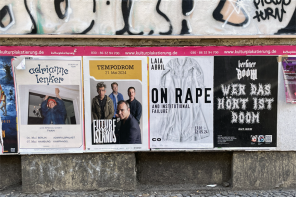The other week, nicola awang was kind enough to schlep her computer to a cafe and let me record a conversation we had about ‘refahmation’, her video installation piece currently on view as part of LUCKY. Made in 2016, ‘refahmation’ is their directorial debut featuring two black women, white supremacy, and self love. At first the women furiously eat a pile of blonde extensions set in front of them, but ultimately abandon it, and begin engaging with one another, each other’s hair, and themselves, with deliberate and affectionate touch. In LUCKY, nicola’s silent film is mounted beneath a banner of blonde that bleeds out onto the floor where a big amorphous pile of blonde hair extensions lie, inviting visitors to interact with it.
Photo by Anastasia Muna
nicola awang: refahmation is my very first film, ever. There’s this class in my university that I took in 2016 called a Directed Study where you ask a professor to mentor you and you create your own syllabus and it can either be a theoretical/historical class—or you can make a performance out of it. I chose the performance aspect. I made this film to accompany my performance art piece. It was playing in the background as I performed as a nun and interacted with the blonde hair after I took off my nun clothes. The film was playing in the background the entire time, alongside Malcolm X’s Who Taught You to Hate Yourself and live music.
harley aussoleil: Why did you choose to dress up like a nun?
n.a.: The spelling of refahmation is how I’d say reformation in Trinidadian. I grew up Catholic so it was like transforming. It was a part of growing up and going to school with a bunch of nuns. That’s where the big pile of hair comes in—it was a part of my performance piece.
I study Contemporary Theater Performance at Simon Fraser University. The thing with my university is that it pushes you to devise your own work and not just go out and audition for stuff. They have a lot of collaborative classes with film students, dance students, and stage production and music students, so they really push for you to create work.
Most of the time we’re reading plays written by old white men, but I think now they’re getting better. I’m reading a lot of Foucault. I don’t usually act in plays or do mainstage productions, except when I auditioned for this play by an indigenous woman, Marie Clements, about indigenous women that were murdered by a barber in the 1960s. We did a table read because no one was indigenous in the play. We brought indigenous folks in to workshop it so that we weren’t being these women but we were letting people know that this happened and that it was fucked up and that this was their story.
h.a.: How did the image in your piece come to you?
n.a.: From the beginning it was two women. It was definitely a reflection of me assimilating and then not assimilating anymore. Like, coming to Canada and trying to fit in, and then realizing that no—I’m never going to. And so, yeah, one day I had this image of these two women eating hair. I don’t know if they’re two parts of me, because they’re both in it together. I don’t know if one is the before or the after, I haven’t interrogated that. But it just came up. It was like a vision, or something.
h.a.: LUCKY is actually your second German showing. Can you tell me about refahmation first being screened at Internationales Frauenfilmfestival in Dortmund Köln last April?
n.a.: It feels good [to have a second showing]. Even to do refahmation—that image of two black women eating blonde hair had been in my head for two years before the film was made. And it materialized only when I finally had the courage to actually do it and meet with my professor to be like, “This is what I want to do”. It took me a long time. But I had to do it.
It was good that it happened because a lot of people’s reactions in North America were like, “You have to confront this”, and they want to talk about race. Whereas in Köln… I guess the way the majority of Germans view and address race is not to confront it, but with my film you have to, there’s no way around it—it pushes you to. I was just watching Sookee [a white Berliner rapper] and was like, “Ok, you’re rapping about feminism and love, but you’re a white person and you’re engaging with black culture, but you’re not addressing your position in society. The only reason why so many people were there was because of her! I was like, “This is wack as fuck.” Ok great, you’re rapping about feminism, ‘love for all’—whatever—but you need to go above and beyond when that is your medium, it’s just the bare minimum. The bar’s been set so low. It was super uncomfortable. It was cringy. I wonder how they thought refahmation would fit into that.
But what’s crazy is, there was a woman from Women Make Waves festival in Taipei, Taiwan and she was like, “We want to show refahmation at a feminist film festival in Taiwan— and I was like, “Ok, alright.” That was a great thing that came out of that. I don’t know what people thought, I don’t know what people thought of it. Maybe that’s a good thing. But I would have loved to know their opinions.
The questions I received after the screening [at the Internationales Frauenfilmfestival] were so surface level. I don’t think, or—it didn’t feel like—she [the moderator] really engaged with the film itself or allowed herself to engage with it. It was weird. And at the end all the participants were given a white rose. It was a lot of older white women with flowy dress and beads. And some were a bit corporate looking. I don’t know. I was like, “I’ll see you at the folk fest, baby.” I’m glad I saw it and bore witness to it.
Still: nicola awang, refahmation, 2016
h.a.: Is that part of what it’s like to negotiate the ‘price’ of having your work seen? What can one do when the same women who give you exposure can’t deal with the work because it implicates them in uncomfortable ways?
n.a.: How much am I paying for it to be seen? What is the price? I feel like that’s never not going to happen. It was shown at Current, a Feminist Electronic Art Symposium for women and non-binary artists. That was POC-run, so I didn’t really feel that as much, so that was a good thing.
h.a.: How do you refuse someone the satisfaction of comfortably watching and consuming something while still giving them work? Certainly you’re not making work with white people in mind.
n.a.: When I performed the original piece I made the film for, I didn’t promote it. I figured my friends would come and I’d set up about twelve chairs in the room. I couldn’t see the audience until I lifted my veil up and there were about forty people in the room in this small space. And I was like: “Stay in it! Stay in it!” What the fuck were all these people doing here? It was like, “Wow, people who have never seen my work care about what I make.” So, that was great. I made it for black women and the black diasporic experience. But non-black POCs and white people were coming up to me saying they felt something or it reminded them of this time in their lives, and I was like, “Oh shit, alright.” I didn’t think I could do this. I thought I knew who could connect to this—I was so sure. But then when other folks came up, it was like, alright. Ok. It wasn’t a thought in my head before.
h.a.: I love that it’s tender, even while being unsettling. And that within LUCKY, it’s not in a dark viewing room, but out in the open where the viewer is visible while taking it in.
n.a.: I really wanted it to have a happy ending because this was a lot, and I’ve been through a lot, but I still wanted a good ending. Not to just leave you ravaged—but that it be hopeful. Even when I was doing my research, looking into a lot of art created from the African diasporic lens—it can be really heavy and I just want to show people there is love and hope even after going through that. I looked into Julie Dash. The Nina Simone song Four Women: that song itself was a huge inspiration. A lot of Deana Lawson photography. Those are the main influences that got me going.
And I wanted to see a happy ending as well. I remember that distinctly. I didn’t want them [the two women in refahmation] to just be ravaged by white supremacy. That they still can love each other and themselves.
Interview by harley aussoleil
Header Image: nicola awang, refahmation, 2016, installation view, LUCKY, nGbK. Photo by Anastasia Muna
nicola awang is a multidisciplinary artist from trinidad and tobago. her practice focuses predominantly on movement and the body. her directorial debut “refahmation” explores the intersection of self love, identity in the age of diaspora, and most importantly black hair and the projected black female form. the short film poignantly displays the artists own self-discovery and her personal journey navigating through oppressive and repressive paradigms. sex, race, class, accessibility, and love converge in all her creative pursuits. the artist currently resides on unceded land of the coast salish people where she continues her exploration and creation of intersectional and collaborative pieces. She can be contacted at nicolaawang[@]gmail.com
harley aussoleil is a member of COVEN BERLIN. She lives in Berlin and is currently in graduate school at the Humbolt-Universität and volunteers part-time as an interpreter.














